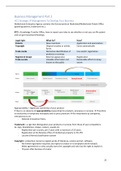Business Management Part 2
HC1 Strategic IP Management To Develop Your Business
Netherlands Enterprise Agency contains the Octrooicentrum Nederland/Netherlands Patent Office
(granting patents, trademark etc.).
KTO = Knowledge Transfer Office; have to report your idea to see whether or not you can file patent
and can get investment/fundings.
Legal right What for? How?
Patents New inventions Application and examination
Copyright Original creative or artistic Exists automatically
forms
Trade marks Distinctive identification of Use and/or registration
products or services
Registered design External appearance Registration
Trade secrets Valuable information not Reasonable efforts to keep
known to the public secret
Appropriability = legitimate ownership of your product
If there is an absence of appropriability (ownership) for products, processes or services → Therefore
no exclusivity or temporary monopoly and no price premium → No investments by companies,
entrepreneurs etc.
- National Innovation Policy
Trademark = a sign that distinguishes your products or services from those of your competitors.
Ex: logo, brandnames, shapes, colours, sounds etc.
- Registration per country, per 5 years with a maximum of 25 years.
- Registration at the Benelux office of intellectual property or EU-IPO
- Locarno (Vienna) classification system
Copyright = protection concerns original works of literature, science and art, software.
- No formal registration required, but rights to creator or to employer (work related).
Make agreements on who actually owns the copyright and who has the right to exploit it.
- 70 years after decease of creator
25
,Patents = new, innovative and applicable technical inventions (products/process). Others are not
allowed to produced, sell, use or stock the invention.
- Max. 20 years exclusivity for commercialization. Have to pay fees in order to keep the patent,
therefore is maximum of 20 years.
- Registration per country – via international procedures
- Internal or Centralized Patent classification (IPC/CPC) system
- Patent search in Espacenet.
- Have to disclose invention (no secret invention). Trade-of patent is that you become the
legitimate owner but have to make your patent public so everyone knows the content.
If you don’t find any patent for it → maybe no market for it?
Can file patent per country, in whole of Europe or International
- WIPO = World Intellectual Property Organization
- EPO = Europe Patent Office
Only when product is in private domain can start exploitation.
‘Metro’ (picture) enables you to become legitimate owner.
Prior art = everything made accessible to the public up to filing date. ‘Making it public’ can mean you
only talked to someone about it, to have files in a library. Doesn’t mean you have to really publish it
on a website or something.
Content application of patent contains:
- Description = explain what product is
- Claims = explain what it does; determines scope of protection
- Figures
Procedure
1. Filing patent
2. Search for prior art by someone (9 months)
3. Strategy on costs and benefits → is the possible patent still useful? Which countries?
4. PCT = worldwide application (<12 months)
5. Search. Have different types:
• Start of research: landscaping (overview of existing solutions,
possibilities/restrictions)
• Before product development: freedom to operate
• Protection of invention by patent: prior art search
6. Publication (<18 months)
7. Examination (<30 months)
After grant
- Infringement → warning, negotiations, court
- Keep patent alive (pay fees)
- Can become invalid (by 3rd party)
Infringement will stop your product sales, production and may have to pay damages. Can avoid
infringement by different solution, licenses and invalidate patent.
When searching for prior art can look into classifications. Every country uses the IPC classification,
but the CPC (Cooperative Patent Classification) in Europe and USA more broad.
26
, HC2 Insight in the Pharmaceutical Industry – IQVIA
Stages Pharmaceutical Product; from molecule to market:
1. Research & discovery
2. Product development
3. Manufacturing and distribution
4. Approval and market access
5. Commercial
Stages can happen simultaneously.
Clinical development = first three stages.
CRO = Contract Research Organization.
Sponsor = pharmaceutical companies such as Pfizer, Roche and Johnson&Johnson.
- Used for outsourcing e.g. clinical development, clinical trial management, pharmacovigilance
and/or outcome research.
- Reduction of costs for sponsors not required to maintain staff for these services.
- Sponsor always retains responsibility in clinical trial.
QVIA helps development pharmaceutical product from molecule to market.
CTcue = software tool developed by QVIA to help system cope with people with heart rhythm
disorder.
Clinical development stage
- Preclinical - animals
- Phase 1 – healthy volunteers; safety (20-80 people)
- Phase 2 – patient population; safety and effectiveness (100-300 people)
- Phase 3 – patient population; safety (side effects) and effectiveness (1000-3000 people)
After this approval for market.
- Phase 4 – Monitor long-term effects
From design to outcome:
- Trial design
- Protocol development
- Site selection = checked if site (place where drug is tested) able to perform a clinical trial.
- Site initiation = make everything ready for come of patients.
- Patient recruitment
- Trial execution = patients are tested
- Site close-out = complete documentation (all findings), when no loose ends can be closed.
- Clinical study report
Have different clinical roles at CRA = Clinical Research Associate:
PICTURE
Roles and responsibilities of a CRA: leverage your expertise, collaborate, execute, ensure quality,
drive productivity, verify compliance (monitoring activities of employees to see if they are doing
what they should do), protect patients, build relationship.
Have 3 options as CRA:
- Work Sponsor-Dedicated (FSP) → work directly with a specific client as part of a team.
- Full service → work with multiple sponsor and develop your skills and passion for a specific
therapeutic area.
- IQVIA biotech → work directly with clients in a collaborative
KOLs = Key Opinion Leaders = specialist who is very active in a specific area.
27





